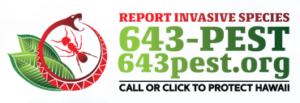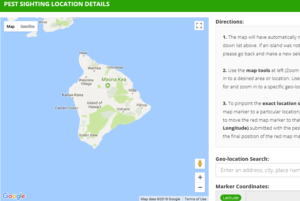New Invasive Species Mobile App Launched
The State of Hawai‘i reports that in the first year of its 10-year plan to strengthen biosecurity, it took dozens of steps to better present, detect and control invasive species in Hawai‘i.
The Hawai‘i Invasive Species Council (HISC), co-chaired by the Hawai‘i Department of Agriculture (HDOA) and Department of Land and Natural Resources (DLNR), has released the first of ten annual progress reports detailing implementation of the Hawaii Interagency Biosecurity Plan (2017-2027). It was released in January 2017 and describes 147 action items that various agencies, the Legislature, and other collaborators can take to control invasive species. At an informational briefing on Wednesday, Jan. 24, 2018, organized by Senator Mike Gabbard, representatives from HDOA, DLNR, the Department of Health (DOH), and the University of Hawai‘i (UH) reported that they have begun work on approximately 40% of the tasks in the bio-security plan.
“This is a shared effort,” said HDOA Chairperson Scott Enright at the informational briefing. He added, “This work is a collaboration across the legislative and executive branches and across the agencies and stakeholders connected to the issue of biosecurity. It’s an all-hands-on-deck issue.”
For HDOA, first-year achievements include the restoration of detector dog teams that are used for agricultural inspections and work on new technologies for digitally tracking incoming cargo that may be considered high-risk for bringing in invasive species. The Department also received the ability to engage in public-private partnerships for inspection facilities, thanks to authorizations in the 2017 Clift Tsuji Act. In the coming year, HDOA will seek funds to develop a biological control research facility as well as additional agricultural loan funds to support local farmers.
At DLNR improvements are being made to the management of ballast water that enters the state within the hulls of ships, often carrying invasive aquatic organisms. DLNR also noted the importance of legislative appropriations in the first year of the plan, enabling work on complex issues like rapid ʻōhiʻa death and rose-ringed parakeets. In coming years, DLNR will be seeking funds and personnel described in the Biosecurity Plan to increase invasive plant and animal control in native forests.
“The Biosecurity Plan highlights how interconnected our work is,” said DLNR Chair Suzanne Case. “The HDOA inspection work at airports directly impacts our ability to protect our mauka forests. Collaborating with DOH on marine vessel cleaning helps reduce new species introductions while ensuring we meet clean water standards. When we work together on these issues, we all win.”
DOH reported at the informational briefing that almost all new positions have been filled following the restoration of Vector Control Branch by the legislature in 2017. The branch is rebuilding a mosquito surveillance network and engaging in outreach on rat lungworm disease. UH provided updates on work by island Invasive Species Committees and the Hawai‘i Ant Lab, projects of the Pacific Cooperative Studies Unit that specialize in detection and rapid response, as well as outreach and training for residents.
At the one-year mark of Biosecurity Plan implementation, the HISC agencies are also collectively announcing the release of a new invasive species reporting site at 643pest.org and a “643-PEST” mobile app available for Android and iOS platforms. The new services are designed to complement the existing 643-PEST invasive species telephone hotline, which will continue to function alongside its new online counterparts. The new initiative allows people to upload photos and map coordinates when reporting invasive species sightings, allowing for faster response by the appropriate agencies.
“We need the public to be our eyes and ears to detect new pests and keep them from becoming established. This new system makes that really convenient.” said Enright. “The new website and app let us receive reports about any type of invasive species and then get it to the appropriate experts,” said Case. “Whether it’s a new threat to agriculture, natural resources, or human health, we want to know about it and make sure the right agencies are working together on a response.”
The system was developed by the Hawai‘i Biodiversity Information Network (HBIN), a project of the University of Hawai‘i’s Pacific Cooperative Studies Unit, with app development by Natural Resources Data Solutions, LLC. In addition to uploading photos and map coordinates, the new system allows users to submit any notes they feel necessary and provides an option for anonymous reporting.















